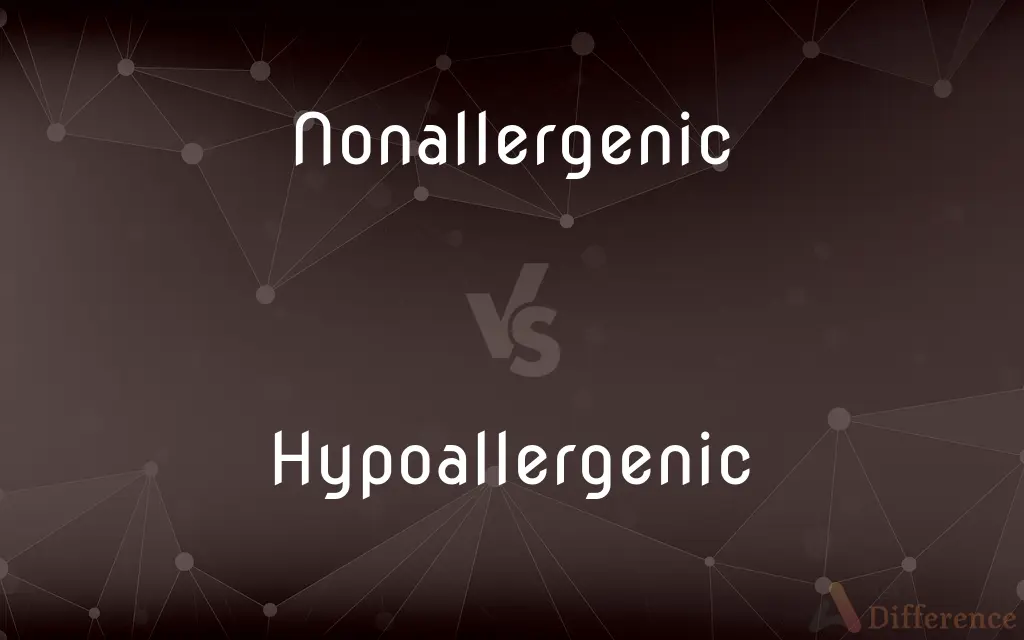Nonallergenic vs. Hypoallergenic — What's the Difference?
By Tayyaba Rehman — Updated on September 14, 2023
Nonallergenic means it won't cause allergies at all, while hypoallergenic means it's less likely to cause allergies but not guaranteed.

Difference Between Nonallergenic and Hypoallergenic
Table of Contents
ADVERTISEMENT
Key Differences
Nonallergenic and Hypoallergenic are terms often used in the context of products, foods, or materials, and they address the likelihood of causing allergic reactions. Nonallergenic, as the prefix "non-" suggests, implies that the item will not cause an allergic reaction. It gives the assurance that the product or material is free from any allergens, making it safe for individuals regardless of their allergic histories. On the other hand, hypoallergenic, with the prefix "hypo-" meaning "below," indicates that the product is less likely to cause an allergic reaction compared to regular products.
Despite these definitions, it's essential to approach these terms with caution. The term hypoallergenic suggests a reduced risk, not the complete absence of risk. Many products labeled as hypoallergenic can still cause allergic reactions in sensitive individuals, albeit at a reduced rate. Nonallergenic, while providing a stronger assurance, doesn't always guarantee the absolute absence of allergens, given the diversity of allergic responses among individuals.
The usage of these terms is widespread in industries like cosmetics, skincare, and pet breeding. For instance, some makeup products claim to be hypoallergenic, appealing to users with sensitive skin. Similarly, certain dog breeds are touted as hypoallergenic, suggesting they won't cause allergic reactions as other breeds might. However, no dog breed is entirely nonallergenic, as allergens can be found in their dander, saliva, or urine.
In essence, while nonallergenic offers a promise of no allergens, and hypoallergenic implies fewer allergens, it's crucial for consumers to test products themselves, especially if they have a history of allergies. Relying solely on these labels might not always ensure safety from allergic reactions.
Comparison Chart
Meaning
Won't cause allergies.
Less likely to cause allergies.
ADVERTISEMENT
Level of Allergen Presence
Supposed to have no allergens.
Supposed to have reduced allergens.
Guarantee
Stronger assurance of no allergic reactions.
Reduced risk, but not a guarantee.
Prefix Understanding
"Non-" means absence of.
"Hypo-" means below or less than normal.
Use in Industry
Less common as it promises complete absence of allergens.
More common, especially in cosmetics and pet breeding.
Compare with Definitions
Nonallergenic
Lacking allergens completely.
The nonallergenic formula ensures no adverse reactions.
Hypoallergenic
Unlikely to cause allergic reactions.
The hypoallergenic lotion is recommended for sensitive skin types.
Nonallergenic
Free from substances causing sensitivities.
The cream is nonallergenic and won't irritate your skin.
Hypoallergenic
Designed to minimize allergy risks.
Many prefer hypoallergenic makeup to avoid skin irritations.
Nonallergenic
Safe for those with allergies.
As a nonallergenic product, it's perfect for those with sensitive skin.
Hypoallergenic
Contains fewer allergens than typical products.
The hypoallergenic pillow reduces the risk of nighttime allergies.
Nonallergenic
Devoid of allergy-causing agents.
The nonallergenic toy is ideal for children of all ages.
Hypoallergenic
Reduced allergen formula.
Pet owners opt for hypoallergenic breeds to minimize allergies.
Nonallergenic
Not causing allergies.
The blanket is made of nonallergenic materials, suitable for all users.
Hypoallergenic
Lower potential for allergenic response.
The hypoallergenic fabric ensures comfort without the itch.
Nonallergenic
Not allergenic; not causing allergies
Hypoallergenic
Hypoallergenic, meaning "below average" or "slightly" allergenic, is a term meaning that something (usually cosmetics, pets, textiles, food, etc.) causes fewer allergic reactions. The term was first used in 1953 in an advertising campaign for cosmetics or perhaps as early as 1940.The term is also commonly applied to pet breeds which are claimed to produce fewer allergens than other breeds of the same species, due to some combination of their coat type, absence of fur, or absence of a gene that produces a certain protein.
Hypoallergenic
Having a decreased tendency to provoke an allergic reaction
Hypoallergenic cosmetics.
Hypoallergenic
Containing fewer allergens; minimally allergenic.
Hypoallergenic
(immunology) Relating to a hypoallergen.
Common Curiosities
Is nonallergenic the same as hypoallergenic?
No, nonallergenic implies no allergens, while hypoallergenic means fewer allergens.
Which term offers a stronger assurance against allergies?
Nonallergenic offers a stronger assurance compared to hypoallergenic.
How are these terms regulated in industries?
The regulation varies, but in some industries, there might be minimal oversight or standardized testing.
And "Hypoallergenic"?
Hypoallergenic means that a product or substance is less likely to cause an allergic reaction compared to regular products, but it's not guaranteed to be allergy-proof.
Are there regulations governing the use of the term "Nonallergenic"?
The regulation varies by country, but in many places, there's no strict standard that defines "nonallergenic."
Can hypoallergenic products still cause allergies?
Yes, they can, as they reduce but don't eliminate allergens.
What does "Nonallergenic" mean?
Nonallergenic refers to substances or products that are not likely to cause an allergic reaction.
Is there a guarantee that "Hypoallergenic" products won't cause allergies?
No, hypoallergenic products reduce the risk of allergic reactions but don't eliminate it entirely.
Are products labeled "hypoallergenic" safe for everyone?
Not necessarily. Those with allergies should still test products individually.
How about regulations for "Hypoallergenic"?
Similarly, regulations differ by country, and in some places, there might not be a stringent definition or testing requirement for the term "hypoallergenic."
Do hypoallergenic and nonallergenic mean the same in all product categories, like makeup, laundry, and jewelry?
The intent behind the terms is the same, but the specific allergens may vary by product category.
Are products labeled "Nonallergenic" safe for everyone?
While nonallergenic products are designed not to cause allergies, individual reactions vary, so it's not guaranteed to be safe for everyone.
How can I be sure a product won't cause an allergic reaction?
It's impossible to be 100% sure, but reading ingredients, doing patch tests, and consulting with professionals can help.
Why are hypoallergenic products often recommended for babies or those with sensitive skin?
They're generally formulated to minimize potential allergens, making them less likely to irritate sensitive skin.
Why might some hypoallergenic products still contain fragrance or dyes?
Hypoallergenic doesn't mean free of all potential irritants, just that it's less likely to cause allergic reactions.
How can I determine if a product is truly nonallergenic for me?
The best method is to conduct a patch test or consult with an allergist or dermatologist.
Are "Nonallergenic" and "Allergen-free" the same?
Not necessarily. While nonallergenic means unlikely to cause an allergic reaction, allergen-free means the product doesn't contain known allergens. But it doesn't guarantee no reactions.
Why do some companies choose to label their products as "Hypoallergenic"?
Labeling a product as hypoallergenic can appeal to consumers with sensitive skin or allergies, suggesting the product may be gentler or safer for them.
Is it possible for someone to still get an allergic reaction from a hypoallergenic product?
Yes, it's possible, as "hypoallergenic" only means the risk is reduced, not eliminated.
Can the environment or exposure impact whether something is hypoallergenic or nonallergenic?
Yes, over time, products can get contaminated, or a person's sensitivities can change, impacting reactions.
Share Your Discovery

Previous Comparison
Fix vs. Modify
Next Comparison
Weasel vs. FisherAuthor Spotlight
Written by
Tayyaba RehmanTayyaba Rehman is a distinguished writer, currently serving as a primary contributor to askdifference.com. As a researcher in semantics and etymology, Tayyaba's passion for the complexity of languages and their distinctions has found a perfect home on the platform. Tayyaba delves into the intricacies of language, distinguishing between commonly confused words and phrases, thereby providing clarity for readers worldwide.














































